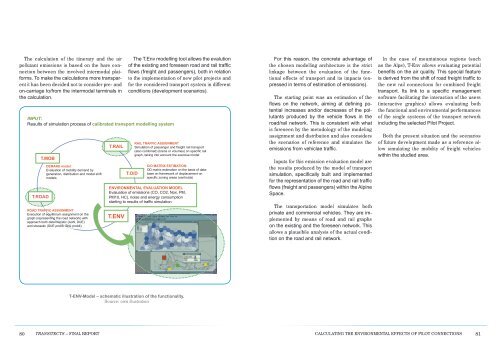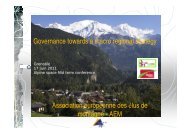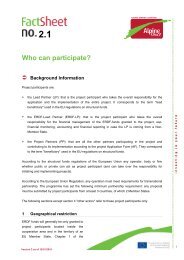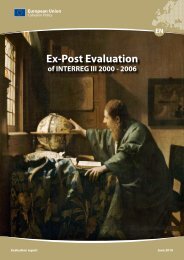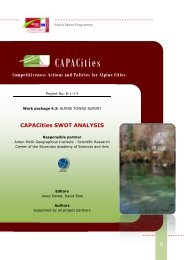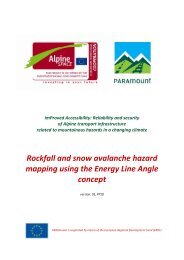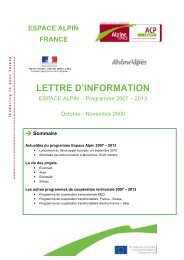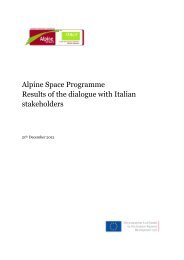intermodal solutions for transalpine freight traffic - Alpine Space ...
intermodal solutions for transalpine freight traffic - Alpine Space ...
intermodal solutions for transalpine freight traffic - Alpine Space ...
Create successful ePaper yourself
Turn your PDF publications into a flip-book with our unique Google optimized e-Paper software.
The calculation of the itinerary and the air<br />
pollutant emissions is based on the bare connection<br />
between the involved <strong>intermodal</strong> plat<strong>for</strong>ms.<br />
To make the calculations more transparent<br />
it has been decided not to consider pre- and<br />
on-carriage to/from the <strong>intermodal</strong> terminals in<br />
the calculation.<br />
The T.Env modelling tool allows the evalution<br />
of the existing and <strong>for</strong>eseen road and rail <strong>traffic</strong><br />
flows (<strong>freight</strong> and passengers), both in relation<br />
to the implementation of new pilot projects and<br />
<strong>for</strong> the considered transport system in different<br />
conditions (development scenarios).<br />
For this reason. the concrete advantage of<br />
the chosen modelling architecture is the strict<br />
linkage between the evaluation of the functional<br />
effects of transport and its impacts (expressed<br />
in terms of estimation of emissions).<br />
The starting point was an estimation of the<br />
flows on the network, aiming at defining potential<br />
increases and/or decreases of the pollutants<br />
produced by the vehicle flows in the<br />
road/rail network. This is consistent with what<br />
is <strong>for</strong>eseen by the metodology of the modeling<br />
assignment and distribution and also considers<br />
the scenarios of reference and simulates the<br />
emissions from vehiclae <strong>traffic</strong>.<br />
Inputs <strong>for</strong> this emission evaluation model are<br />
the results produced by the model of transport<br />
simulation, specifically built and implemented<br />
<strong>for</strong> the representation of the road and rail <strong>traffic</strong><br />
flows (<strong>freight</strong> and passengers) within the <strong>Alpine</strong><br />
<strong>Space</strong>.<br />
In the case of mountainous regions (such<br />
as the Alps), T-Env allows evaluating potential<br />
benefits on the air quality. This special feature<br />
is derived from the shift of road <strong>freight</strong> <strong>traffic</strong> to<br />
the new rail connections <strong>for</strong> combined <strong>freight</strong><br />
transport. Its link to a specific management<br />
software facilitating the interaction of the users<br />
(interactive graphics) allows evaluating both<br />
the functional and environmental per<strong>for</strong>mances<br />
of the single systems of the transport network<br />
including the selected Pilot Project.<br />
Both the present situation and the scenarios<br />
of future development made as a reference allow<br />
simulating the mobility of <strong>freight</strong> vehicles<br />
within the studied area.<br />
The transportation model simulates both<br />
private and commercial vehicles. They are implemented<br />
by means of road and rail graphs<br />
on the existing and the <strong>for</strong>eseen network. This<br />
allows a plausibile analysis of the actual condition<br />
on the road and rail network.<br />
T-ENV-Model – schematic illustration of the functionality.<br />
Source: own illustration<br />
80 transitects – final report<br />
CalCulating the environmental effeCts of pilot ConneCtions<br />
81


